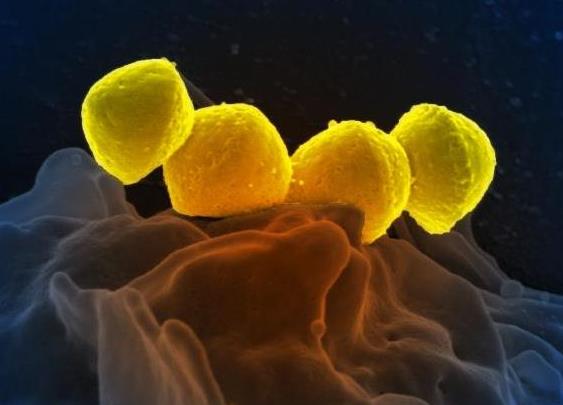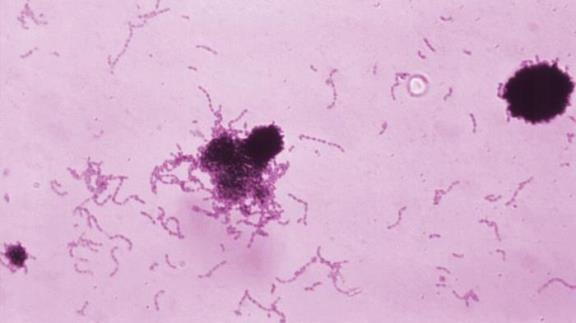Key Concepts
A genus of spherical or ovoid bacteria (some being notably pathogenic) that are characteristically arranged in pairs or in chains resembling strings of beads. Numerous bacteria are assigned to the genus Streptococcus. They are commonly referred to as streptococci and can be isolated from humans and other animals. Many members of the streptococci constitute part of the normal microbial flora of the mouth, throat, intestine, and skin and are harmless commensal forms; in contrast, other streptococci are highly pathogenic (Fig. 1). The cells are gram-positive (that is, they retain a violet color when Gram's stain is applied) and can grow either anaerobically or aerobically, although they cannot utilize oxygen for metabolic reactions. Glucose and other carbohydrates serve as the sources of carbon and energy for growth. All members of the genus lack the enzyme catalase (which catalyzes the decomposition of hydrogen peroxide into molecular oxygen and water). See also: Bacteria; Bacteriology; Carbohydrate; Enzyme; Glucose; Human microbiota; Medical bacteriology; Microbiome; Oxygen; Pathogen

Classification
Classification of the streptococci can be based on hemolytic, serologic, or physiologic reactions or on genetic similarities (see table). See also: Bacterial taxonomy
| Species or division | Hemolytic reactions | Serologic reactions | Diseases | Comments |
|---|---|---|---|---|
|
S. pyogenes |
Beta |
Lancefield group A |
Pharyngitis, impetigo, scarlet fever |
Causes strep throat infection, which may be followed by rheumatic fever or glomerulonephritis |
|
S. agalactiae |
Beta, gamma (rare) |
Lancefield group B |
Neonatal infections (septicemia and meningitis), urinary tract infections |
Causes overwhelming infection in newborns, which is transmitted from the mother during birth |
|
Group C and G streptococci |
Beta |
Lancefield group C or G |
Pharyngitis, skin and soft tissue infections |
Have different Lancefield antigens, but are physiologically and genetically very similar |
|
S. gallolyticus (S. bovis) |
Gamma, alpha |
Lancefield group D |
Endocarditis |
Presence in the bloodstream often associated with colon cancer |
|
S. pneumoniae |
Alpha |
Various capsular antigens |
Respiratory, ear, and eye infections |
Antigens in the cell's capsule (an outer polysaccharide layer) are used to classify S. pneumoniae bacteria into serologic types |
|
Viridans streptococci |
Alpha, gamma, beta |
No Lancefield antigen or group A, C, F, or G |
Endocarditis, abscesses |
Include various species, such as S. mutans (an agent of dental caries) and S. anginosus (a cause of abscesses) |
|
Nutritionally variant streptococci |
Alpha |
Unique type of antigens |
Endocarditis |
Require vitamin B6 for growth |
Hemolytic reactions
The action of streptococci on blood cells that have been incorporated into solid, agar-containing media was one of the first characteristics used to classify streptococci. Some strains cause beta hemolysis (that is, lysis of blood cells), which is visualized as clear zones surrounding colonies on blood agar. Other streptococci are alpha-hemolytic, causing a greenish discoloration of blood-containing media. The term gamma hemolysis actually describes the inactivity of streptococci on blood cells; these strains are also known as nonhemolytic. See also: Blood; Lytic reaction
Serologic reactions
In the 1930s, Rebecca C. Lancefield began her serological studies of streptococci and proposed a scheme for classifying these bacteria into groups on the basis of antigens (substances that cause the immune system to produce specific antibodies or T cells against it) present in their cell walls. The antigen (known as Lancefield group antigen) is extracted chemically from the cells of a given strain and then is reacted with a series of antisera, with each containing antibodies specific for a single Lancefield group antigen. See also: Antibody; Antigen; Serology
The different groups are denoted by letters of the alphabet. A streptococcus containing an antigen reacting with an antiserum specific for group A, but not with other antisera, is classified as a group A streptococcus. Positive reactions are denoted by the formation of a precipitate of antigen–antibody complexes (the precipitin reaction) or by the agglutination of antiserum-coated latex beads in the presence of antigen. According to Lancefield's classification scheme, all strains with the same group antigen are considered to be closely related and usually members of the same species. Streptococci of some groups can be subdivided on the basis of type antigens, such as the M-protein type antigens present in group A streptococci. See also: Antigen-antibody reaction
Lancefield's classification system is often used for identifying many beta-hemolytic streptococci of medical importance. Rapid tests for identifying group A streptococci causing strep throat (streptococcal pharyngitis) are based on the detection of the group A Lancefield antigen in streptococci removed from the throat on a swab. However, Lancefield serology is not useful for identifying most alpha-hemolytic and nonhemolytic strains because possession of a given Lancefield group antigen does not usually correlate with the species identity of strains of these streptococci.
Physiologic reactions
Physiologic activities (for example, the ability to metabolize certain carbohydrates, produce various enzymes, or grow in the presence of different inhibitory compounds) can be used to classify streptococci to the species level. These reactions are most useful for identifying non-beta-hemolytic strains that cannot be easily classified by Lancefield serology.
Genetic similarities
Studies of genetic (nucleic acid) similarities among streptococci have revealed that two major groups of organisms (enterococci and lactococci) that were previously thought to be streptococci really belong in separate genera. Enterococci possess Lancefield group D antigen, but they are different from group D streptococci by virtue of their physiologic properties [they are able to grow in the presence of bile and high salt concentrations, and at both 45°C (113°F) and 10°C (50°F)]. Genetic studies have shown that these organisms belong in a separate genus, Enterococcus. Lactococci were previously considered to be streptococci with Lancefield group N antigen. These organisms have been reclassified in the genus Lactococcus. Lactococci are found on plants and in foods, and they are important in the dairy industry.
Pathogenicity
Streptococcus pyogenes (group A) [Fig. 1] is well known for its participation in many serious infections. It is a common cause of throat infection (strep throat), which may be followed by more serious complications, including rheumatic fever, glomerulonephritis, and scarlet fever. Increases in the incidence of rheumatic fever and severe group A streptococcal infections, sometimes associated with a toxic shock–like syndrome, have been noted. This rise in serious group A streptococcal infections is probably associated with increased virulence properties in some strains of these streptococci. Other beta-hemolytic streptococci with Lancefield group C and G antigens participate in similar types of infection, but they are usually not associated with rheumatic fever and glomerulonephritis. Group B streptococci, which are usually beta-hemolytic, cause serious infections in newborns (including meningitis) and adults. See also: Kidney disorders; Meningitis; Rheumatic fever; Scarlet fever; Toxic shock syndrome; Virulence
Among the alpha-hemolytic and nonhemolytic streptococci, S. pneumoniae is an important cause of pneumonia and other respiratory infections; in many cases, S. pneumoniae has become resistant to one or more antibiotics. The viridans streptococci (for example, S. mutans; Fig. 2) comprise a number of species commonly isolated from the mouth and throat. Although normally of low virulence, these streptococci are capable of causing serious infections (endocarditis, abscesses, and dental caries). See also: Antibiotic; Antibiotic resistance; Dental caries; Drug resistance; Heart disorders; Pneumonia; Streptococcus pneumoniae (pneumococcus)






